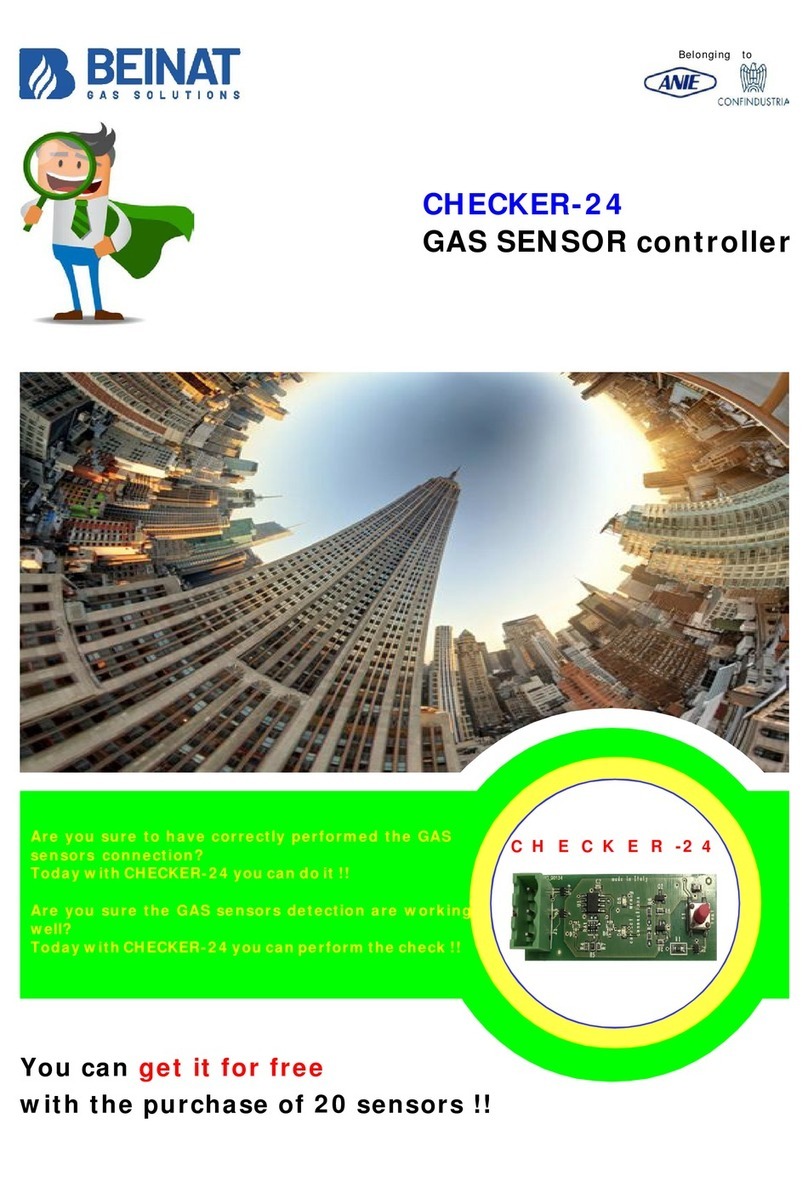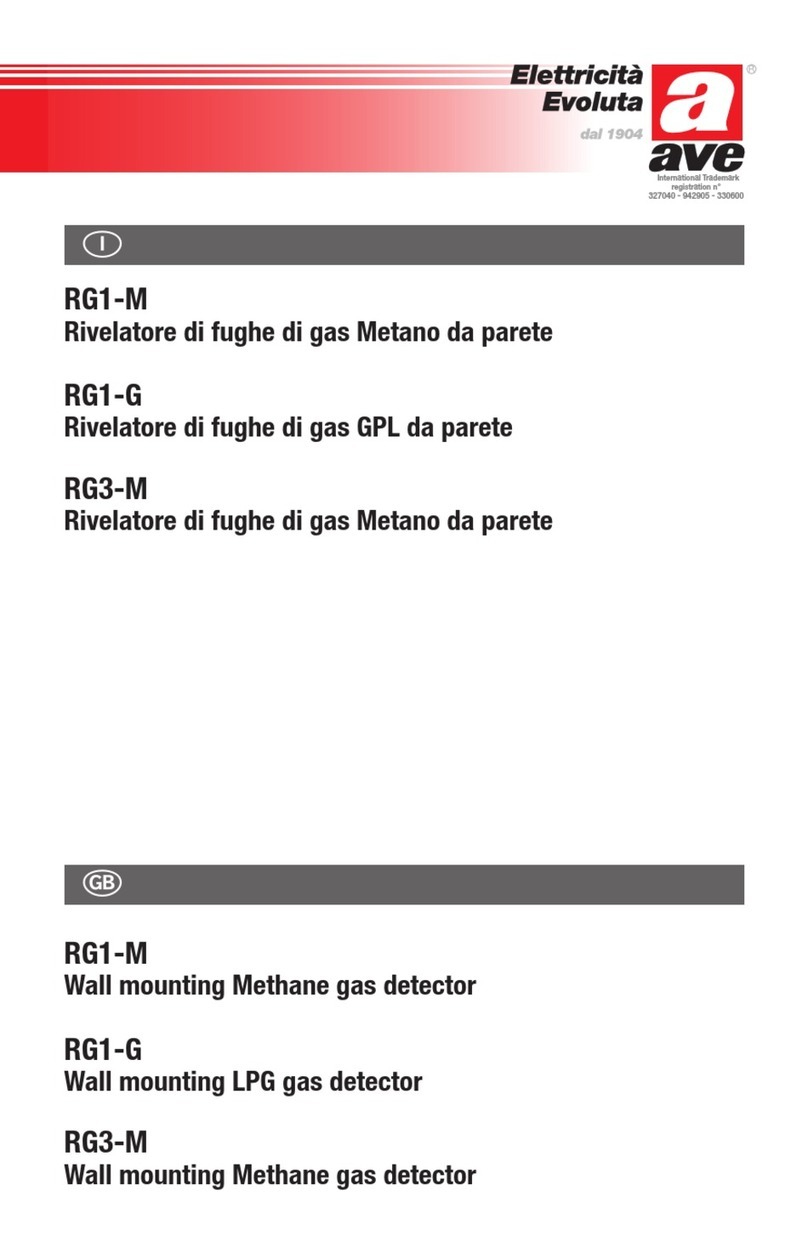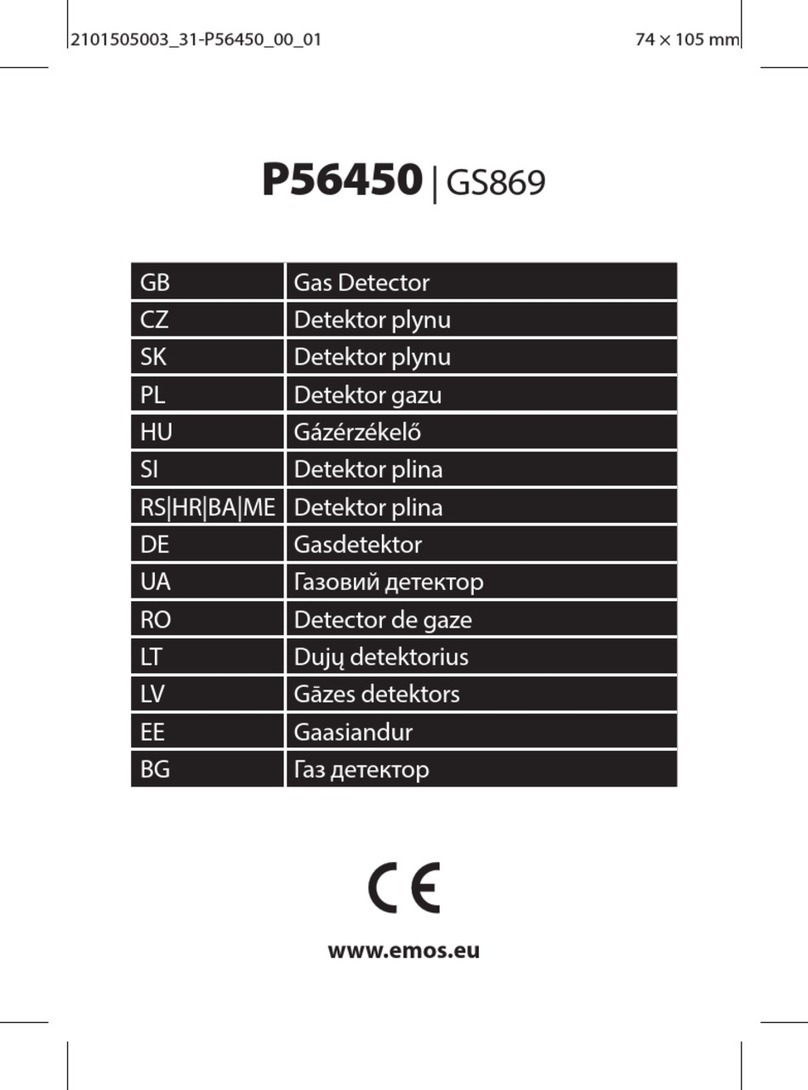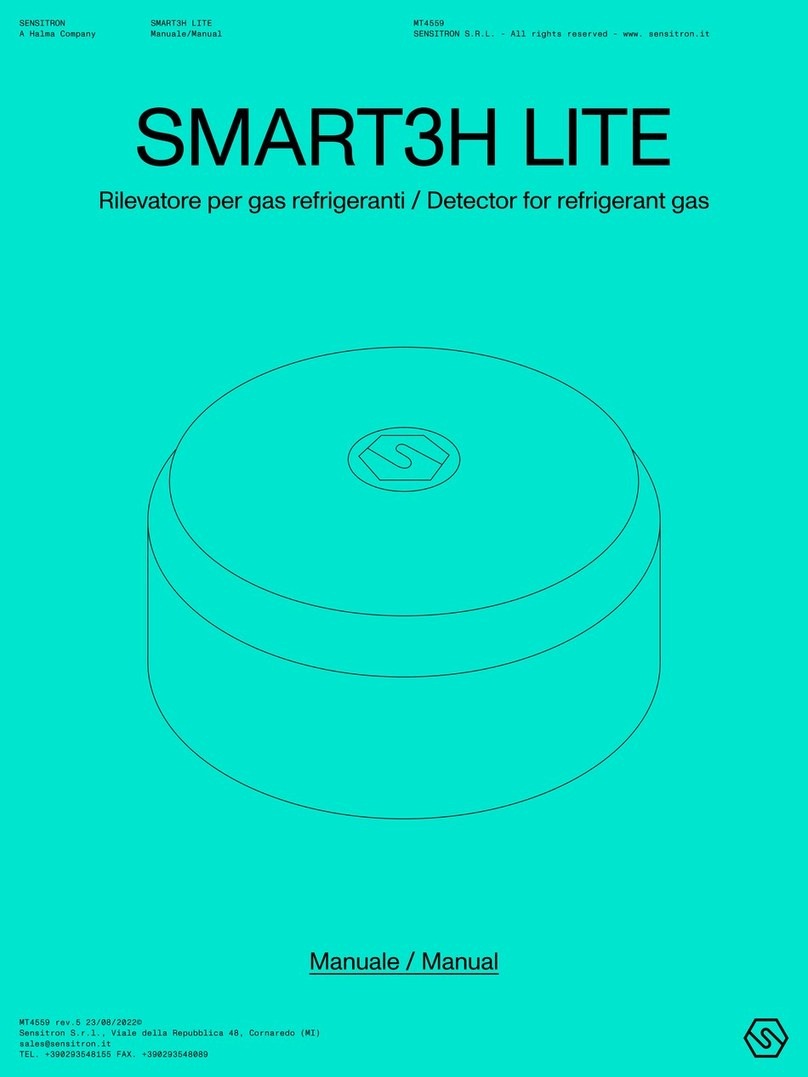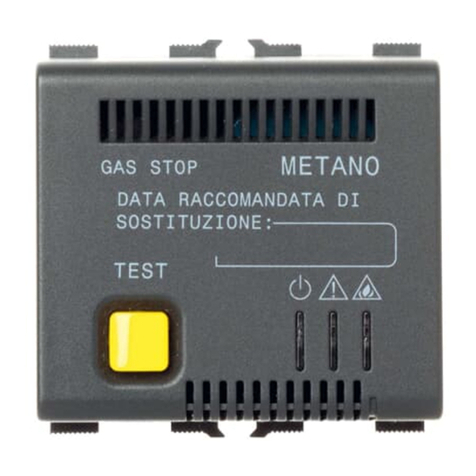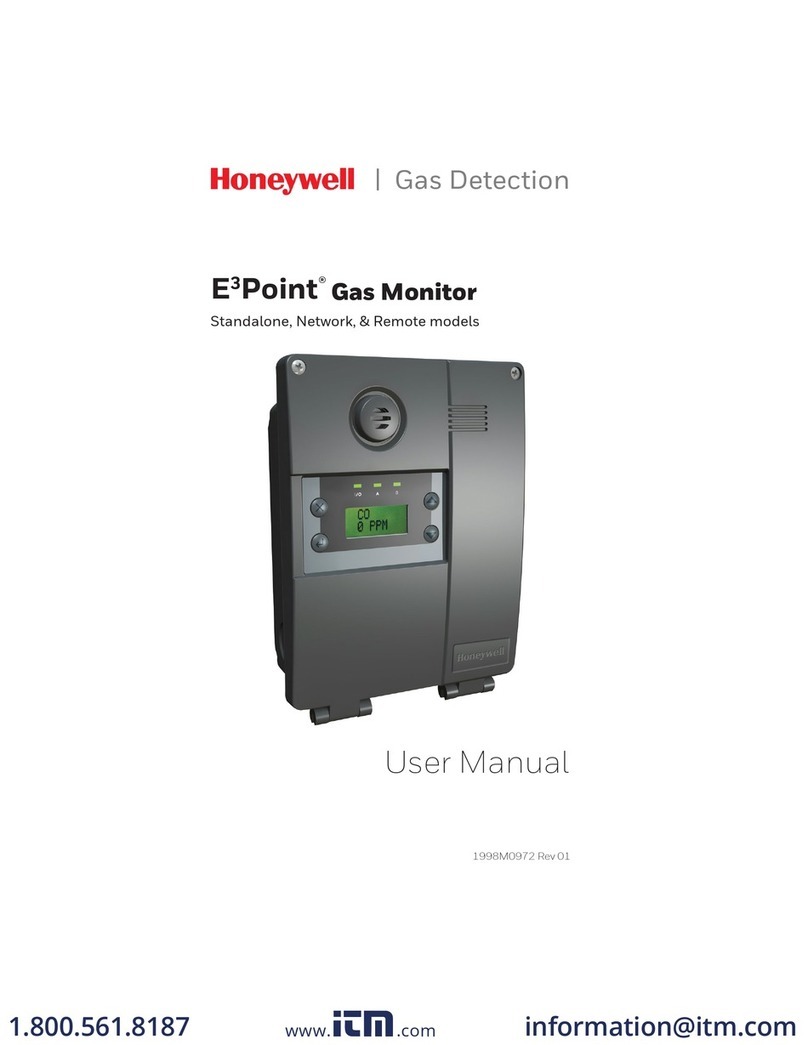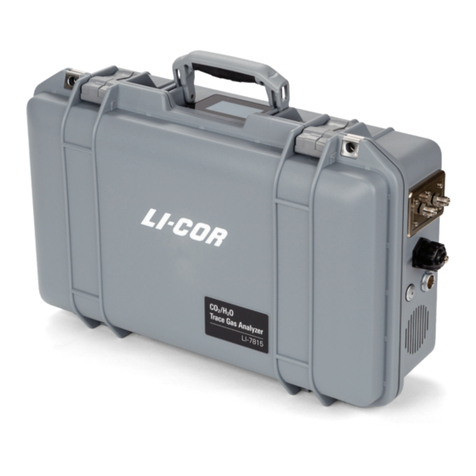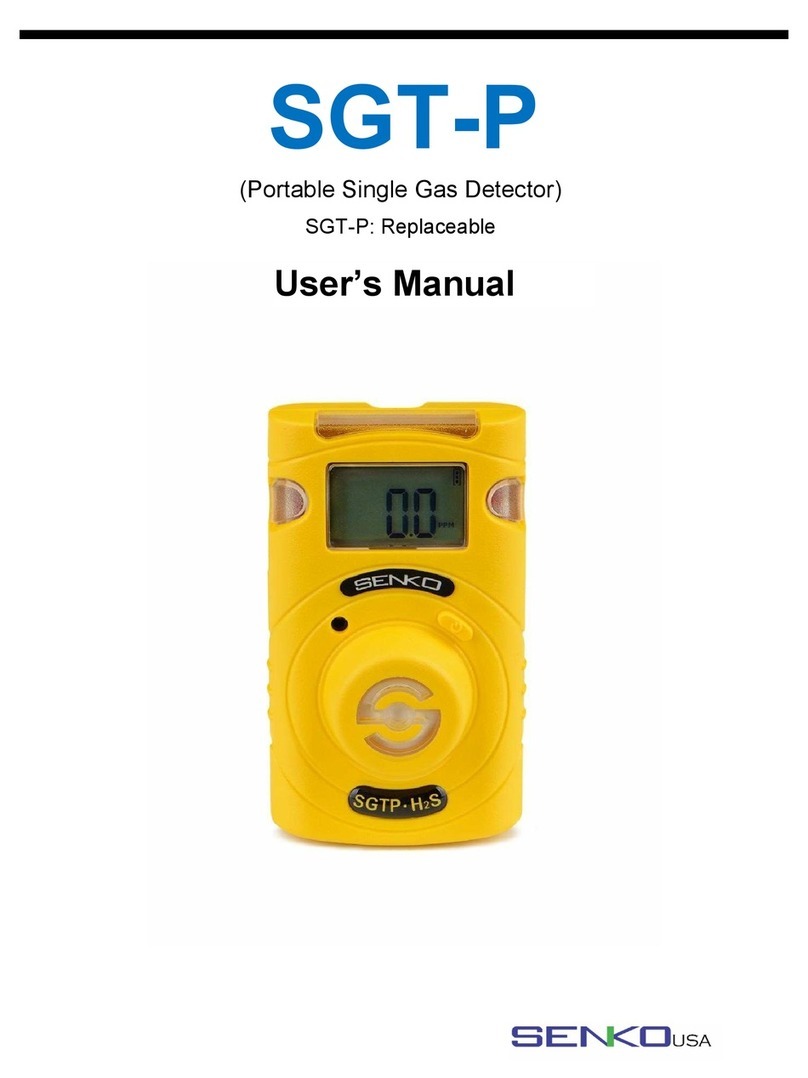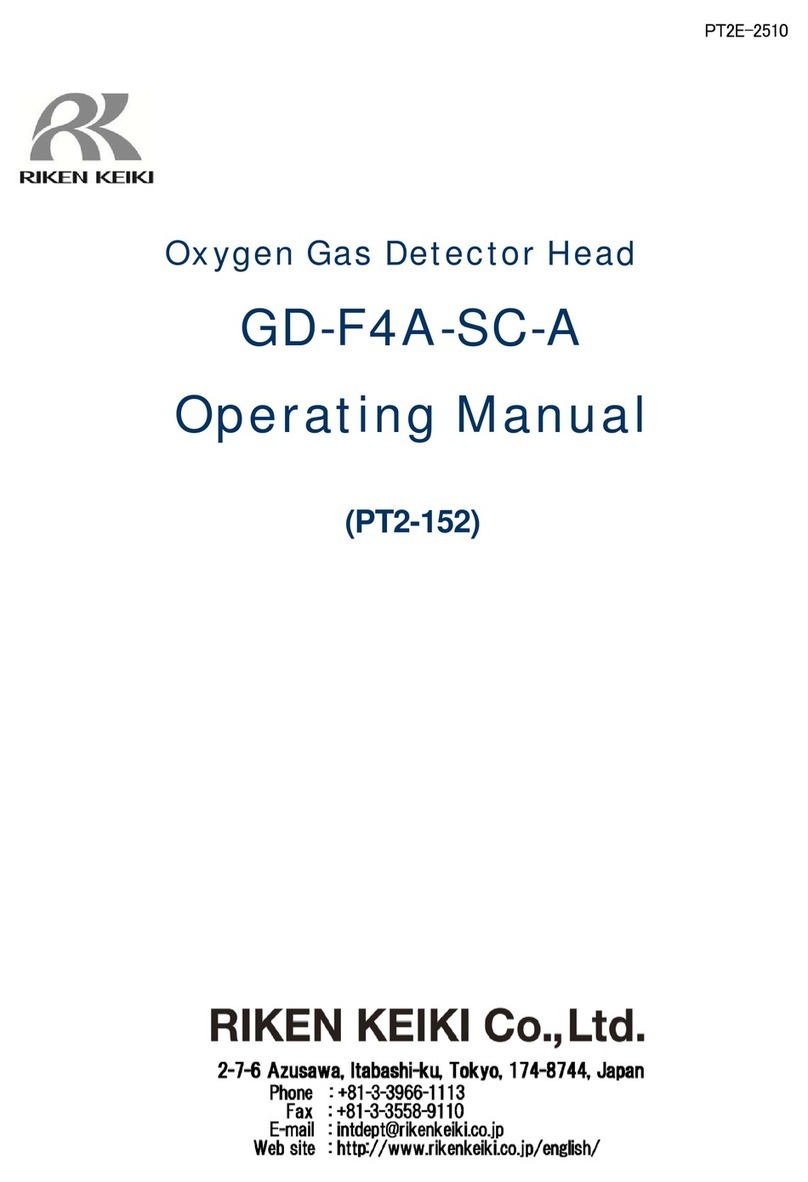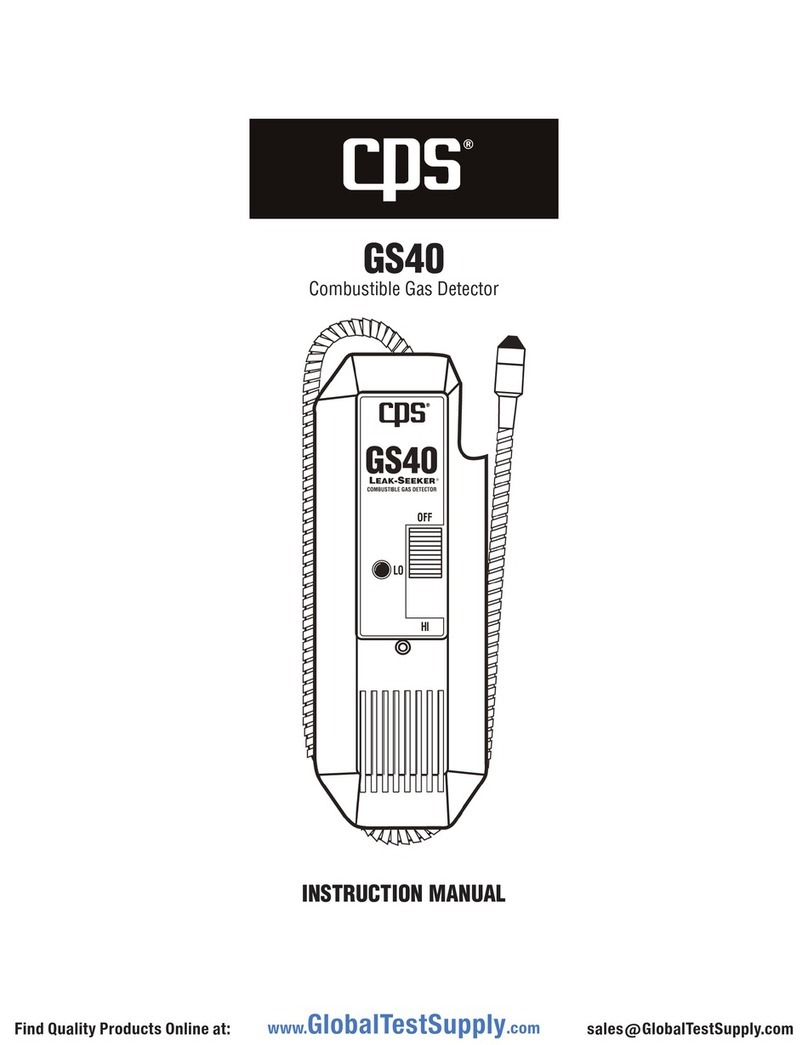BEINAT CHCO User manual

Made in Italy
F i r m w a r e .
Versione 3 . 1
Firmware
Version 1.0
CONFORMITY EN50194
EN50291
CEI216-3
EN50270
CHCO
Belonging to
CHCO Double Gas Detector
The CHCO Detector has been designed and built according to European regulations to
detect the presence of toxic and explosive gas.
A microprocessor is used to create a complete surveillance and control system with
maximum flexibility. Thanks to this and its other features, this detector is suitable for
household applications.
The CHCO Detector can detect the presence of two gases.
The first gas detected is Methane, with trip sensitivity calibrated at 10% of L.E.L.
The second gas detected is Carbon Monoxide, when both the maximum CO admissible
concentration threshold of 300ppm is exceeded, and when low CO concentrations persist
in the environment for lengthy periods, which according to the principle of accumulation
could also damage the human organism.
The probe can activate solenoid valves, sirens, and any other signal or alarm handling
devices using built-in relays. A series of technical features make this detector extremely
versatile, reliable, accurate, and safe.
The relay, free of voltage, allows installation of multiple detectors on a single solenoid valve
ensuring control of multiple dangerous environments.
The detector is complete with a special circuit that controls the sensor’s efficiency level, and
signals any possible fault. The external container has an IP42 protection degree.
User Guide
ImportantNote
Before connecting the unit careful reading of instruction booklet is recommended, and it is kept
in a safe place for future reference. Furthermore, the correct electrical connections according to
the enclosed drawings, complying with instructions and Regulations in force, is recommended.

Page 2
Precautions
CHECK the integrity of the unit after having removed it from the box.
Check that the data written on the box correspond to the type of gas used.
When doing the electrical connections, follow the drawing closely.
Any use of the detector for purposes other than the intended one is considered improper, and as a
result of which BEINAT S.r.l. therefore disclaims any responsibility for possible damages caused to
people, animals or objects.
IMPORTANT: Do not test the device using the gas tap as this does not necessarily provide sufficient
concentration to activate the main alarm.
TERMS and EXPECTATIONS: The installation of the CHCO gas detector, its ordinary and extraordinary
maintenance, every six months, and its out of service removal at the end of the functional life
guaranteed by the manufacturer, must be carried out by authorized or specialized personnel.
In order to achieve long and satisfactory use of your CHCO gas detector,, use it by respecting the
following precautions.
Do not drop it.
Heavy knocks or falls during transportation or installation can damage the appliance.
Avoid abrupt temperature fluctuations.
Sudden temperature variations can cause condensation and the detector could work poorly.
Above about +40°C, the detector could become very sensitive, and generate false alarms.
Do not allow it to become wet.
The control unit can be seriously damaged as it is not waterproof either when immersed in water or
exposed to high levels of humidity.
Cleaning
Never clean the device with chemical products. If necessary, wash with a moist cloth.
Technical Specifications
Powersupply ................................................................................................230Vac50 Hz +/- 10%
Powerconsumption......................................................................................................................1W
Change-over relays for explosive gas detection .................... 10A 250V ~ resistive 5A 30Vdc resistive
Change-over relays for CO toxic gas detection ....................10A250V~ resistive5A30Vdc resistive
Explosivegassensor.................................................................................................................Catalytic
ExplosionAlarmThreshold .......................................................................................At 10% of L.E.L.
CO toxic gas sensor ......................................................................................... Electrochemical Cell
COdetectoralarmsensitivity.............................................................................................30÷300ppm
CO gas detector alarm threshold according to norm EN 50291 on gas accumulation 30 to 300ppm
Audible and visual signal alarm by .................................................................... LED diode and buzzer
Sensors’ faults detected by Fault Circuit ........................................ Interruption, short circuit, or wear
FunctioningTemperature ...........................................................................................-10°Cto+40°C
FunctioningHumidity.................................................................................... 0÷90%RHnoncondensed
Electromagnetic Compatibility “CE Reference Norms ” ....................................................... EN 50270
External degreeof protection ...................................................................................................IP42
Mounting ....................................................................... External wall mount, or embedded box 503
Body material .............................................................................................. ABS self-extinguishing
Dimensions.....................................................................................................................115x150x52
Warranty ...............................................................................................................................3years
Operatingspecificationsof thegassensors
The ELECTROCHEMICAL CELL technology sensor has a duration of: 5 years.
The CATALYTIC technology sensor has a duration that can vary: from 5 to 6 years.
The sensor’s functioning temperature, independently of the technology used, ranges from -10°C to
+40°C
ATTENTION!
The CATALYTIC probe does not tolerate a gas detection exceeding 100% of L.E.L., with consequent
natural death of the sensor.
Each immediate puff of gas that exceeds 100% of L.E.L. takes away months of life from the sensor.
To test the toxic gas, issue gas from a pre-calibrated aerosol from 30 to 300 ppm, into the grey
sensor.
Please see point 6. Using other types of gas is useless and could damage the sensor.
The detector must be tested by simulating the presence of gas issuing it from a pre-calibrated
aerosol.
One per each type, explosive or CO.

CHCO
9 Replaced
by 2014
S.N. 12472
Year 2010
Year 2010
1
23
8
1 2 3 4 5 6 7 8
5
6
7
4
Page 3
34 mm
50 mm
Measures
Embedded box 503
70 mm
105 mm
5 mm
150 mm
84 mm
115mm
Componentsandcommands
1) MAINS connected indication LED. When the unit turns on, this LED blinks and a test of the gas
detection sensors’ efficiency status is carried out. This phase takes about 100 seconds. Afterwards
the LED stays on without blinking. During the test period, the CHCO does not detect the gas.
2) FAULT indication LED. If this LED turns on, it means that one of the gas detection sensors is not
working efficiently and must be replaced in an authorized centre.
A relay is connected to the fault circuit as well as the light indication and a “cricket” siren.
3) CO ALARM indication LED. This LED will light up when the gas concentration level has reached the
300ppm concentration, or when the accumulation level is reached. The relay contact is closed, and
an impulsive sound is issued.
4) Explosive GAS ALARM indication LED. This LED will light up and blink when the gas concentration
level has reached 10 % of LEL. The relay contact is closed, and an intermittent sound is issued.
6) Catalytic sensor for Methane explosive gas detection.
5) Electrochemical Cell sensor for Carbon Monoxide detection
7) TEST button. This button is used to simulate a gas leak, after installation.
8) Identification label, registration number and manufacturing year, located under the ABS small
dome.
9) Label of the gas sensor expiration date.
This label must be applied by the technician during the installation and remembering that the gas
sensor must be reviewed after 5 Years.

Page 4
Installationmeasuresandpositioning
Turnonandtesting
Install the CHCO on the wall opposite the possible source of danger, example: kitchens, boilers, or
else. Moreover, the detector should not be installed behind barriers that prevent the prompt
detection of gas, near vents or fans, and in rooms where temperature falls below -10°C or over 40°C.
When powering on the CHCO, you will see that the MAINS LED lights up and starts blinking for about
100 seconds. Afterward the LED stays on without blinking. Now, the CO922 is ready.
To test the toxic gas, issue gas from a pre-calibrated aerosol from 30 to 300 ppm, into the grey
sensor. Please see point 5,pge 3. Using other types of gas is useless and could damage the sensor.
The ALARM LEDs will light up, and the relays will shift their functioning mode.
Gas detection sensor in ppm Detection Diagram
After the alarm, the LED will turn off, the buzzer will stop, and the connected appliances will be turned
off.
The position of the detector is a crucial factor for its correct functioning during gas detection.
In order to obtain the maximum results from a device and minimize the probability of false alarms,
it is recommended to follow this scheme and keep in mind the following general regulations.
The detector must be located at different heights, according to the type of gas. These heights are:
- 30 cm from the highest point of the ceiling in order to detect light gases, Methane
- The detector should not be placed near the appliances to be controlled (boilers, burners, industrial
kitchens, etc.) but on the opposite wall.
- The detector should not be affected by smoke, vapour, etc. as they could distort its measurement.
It should be located away from sources of heat, ventilators or fans.
Rilevatore
Gas GPL
30 cm
max
1-4 m
30 cm
max
1-4 m
Gas detector
CHCO METHANE
N O ! N O !
YES
0 15 30 45 60 75 90 105 120 135 150
30 ppm CO
50 ppm CO
100ppm CO
300ppm CO
Detection Diagram
GAS Detection in ppm
Clean
Air
Time in minutes

Page 5
... from the compliance with all regulations concerning the characteristics, installation and use of
gas appliances.
Particularly, the ventilation of the spaces and the elimination of combustion products are
described in the UNI norms according to ART. 3 LAW 1083 / 71 and relevant legal provisions.
The installation of the detector does not exempt...
1) Put out all free flames.
2) Close the main gas tap or the LPG cylinder tap.
3) Do not turn any lights on or off; do not turn on any electrical device or appliance.
4) Open windows and doors in order to increase ventilation.
If the alarm stops, its cause must be found and the relevant consequent measures taken.
If the alarm continues and the cause of gas presence cannot be found or removed, abandon the
building and call the emergency services when outside (fire department, distributors, etc.)
Warning !!
If you have the following symptoms: vomiting, sleepiness, or else, go to the closest first aid
station and inform the operators that you could have been poisoned by Carbon Monoxide.
WARNING! Actions to be taken in case of alarm
- If the device does not start up.
Check that the 230V power is correctly connected.
- If the fault LED lights up.
If the YELLOW LED is remains ON, check the detection capsule status. It is probably faulty and has
to be replaced. Call an authorized technician.
- If the detector is repeatedly issuing an alarm.
Check that there are no gas leaks.
If the alarm signal and the FAULT indicator light turn on together, proceed as in the previous
paragraph.
- If the detector is issuing an alarm and does not shut off the devices connected to it.
Check that the wiring is correct and that the jumper that carries power to the relay has been set
properly. All relays are free from electrical power. Check the drawing of the connections.
If other problems arise, a specialised and/or authorised technician and/or the Distributor of
BEINAT S.r.l. should be contacted directly.
Beforecallingatechnician

N
Ph
1 2 3 4 5 6 7 8
NC C
NO
NC C
NO
Relay Alarme
Gas CO
Relay Alarm
Gas methane
N
Ph
1 2 3 4 5 6 7 8
NC C
NO
NC C
NO
Fan
Electrovalve
Page 6
Electricalconnections
WARNING
Before connecting to the mains power, ensure the voltage is correct.
Carefully follow the instructions and the connections according to Regulations in force, keeping
in mind that the signal cables should be laid separate from the power cables.
Connection Scheme of CHCO Detector
WARNING !
The Relay is free of voltage.
Power Supply
230 V AC
Connection Scheme normally close valve 230VAC
WARNING !
The Relay is free of voltage.
Power Supply
230 V AC

Page 7
Ph
N
Connection
230V ca
1 2 3 4 5 6 7 8 1 2 3 4 5 6 7 8
N
Ph
1 2 3 4 5 6 7 8
NC C
NO
NC C
NO
Fan
Electrovalve
Ph
N
Connection
230V ca
1 2 3 4 5 6 7 8 1 2 3 4 5 6 7 8
Connection Scheme normally open valve 230VAC
WARNING !
The Relay is free of voltage.
Power Supply
230 V AC
One or more detectors with a normally open valve 230VAC
One or more detectors with a normally close valve 230VAC
WARNING !
The Relay is free of voltage.

Made in Italy
TO BE FILLED AFTER INSTALLATION
In agreement with our continuous development policy, we reserve the right to modify our products without notice.
Purchase Date
BEINAT S.r.l. Via G. Bossetto 3 - 10073, Ciriè (TO) - ITALY
Tel. 011.921.04.84 - Fax 011.921.14.77
E- mail - info@beinat.com - http:// www.beinat.com
INSURANCE. This device is insured by the SOCIETÀ REALE MUTUA for the PRODUCT'S GENERAL
LIABILITY up to a maximum of 1,500,000.00 EURO against damages caused by the device in case of
failures in functioning.
WARRANTY. The warranty term is 3 years from manufacturing date, in agreement with the following
conditions. The components acknowledged as faulty will be replaced free of charge, excluding the
replacement of plastic or aluminium cases, bags, packing, batteries and technical reports.
The device must arrive free of shipment charges to BEINAT S.r.l.
Defects caused by unauthorized personnel tampering, incorrect installation and negligence resulting
from phenomena outside normal functioning shall be excluded from the warranty.
BEINAT S.r.l. is not liable for possible damage, direct or indirect, to people, animals, or things; from
product faults and from its enforced suspension of use.
CHCO GAS DETECTOR Styling by b&b design
Stamp and signature of the dealer
Registration Number
ppm
5000 DEATH within 20 minutes
1500 DEATH within 2 hours
800 CONVULSIONS within 30 minutes
450 STRONG HEADACHE
250 HEADACHE within 3 hours
150 HEADACHE within 2 hours
Symptoms of Carbon Monoxide
“CO” poisoning
Table of contents
Other BEINAT Gas Detector manuals
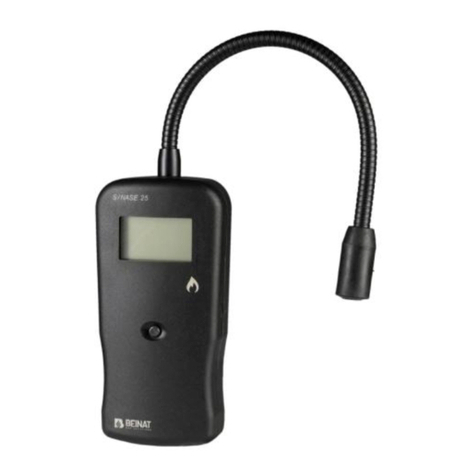
BEINAT
BEINAT NASE25/K Instruction manual
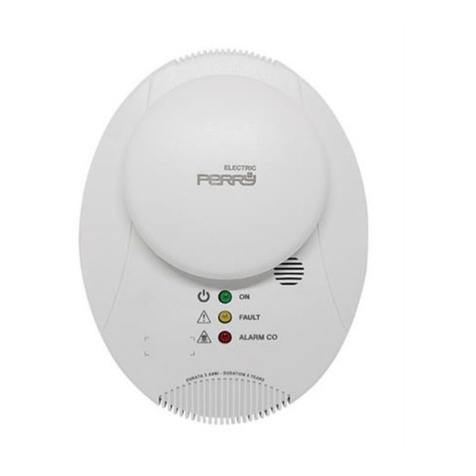
BEINAT
BEINAT RGX100 User manual
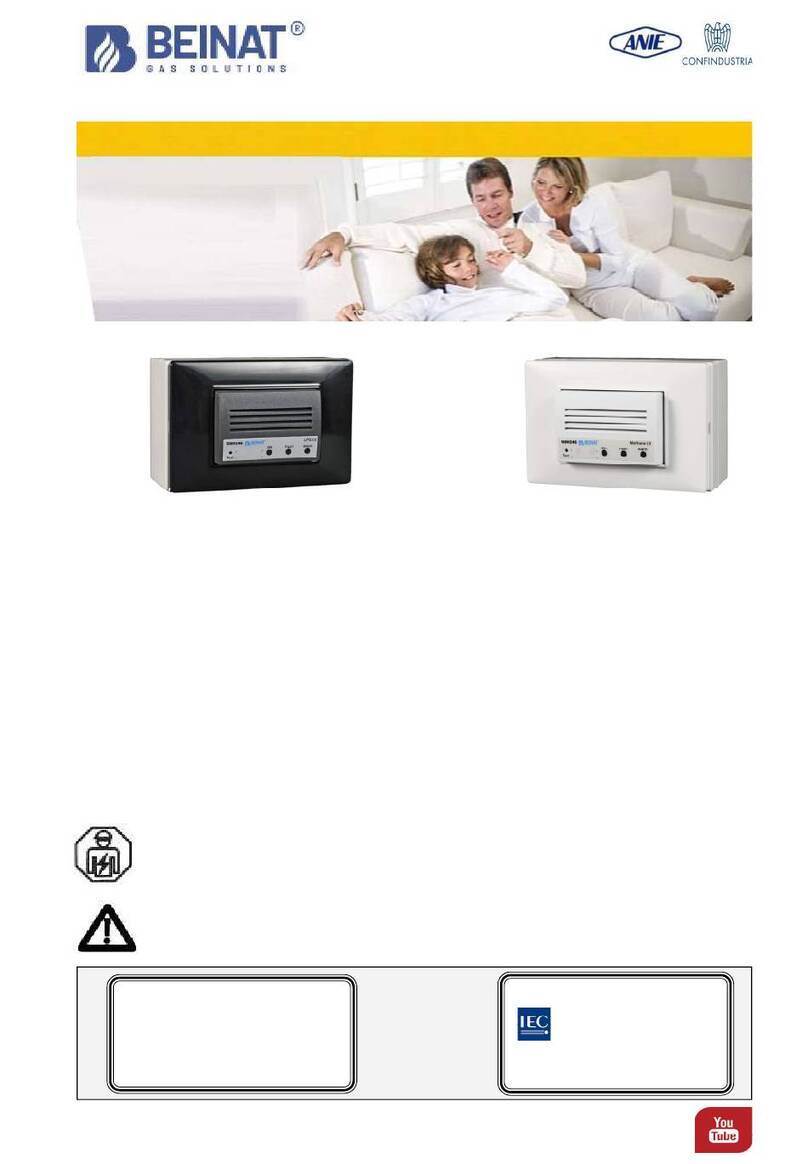
BEINAT
BEINAT GSH246 Series User manual
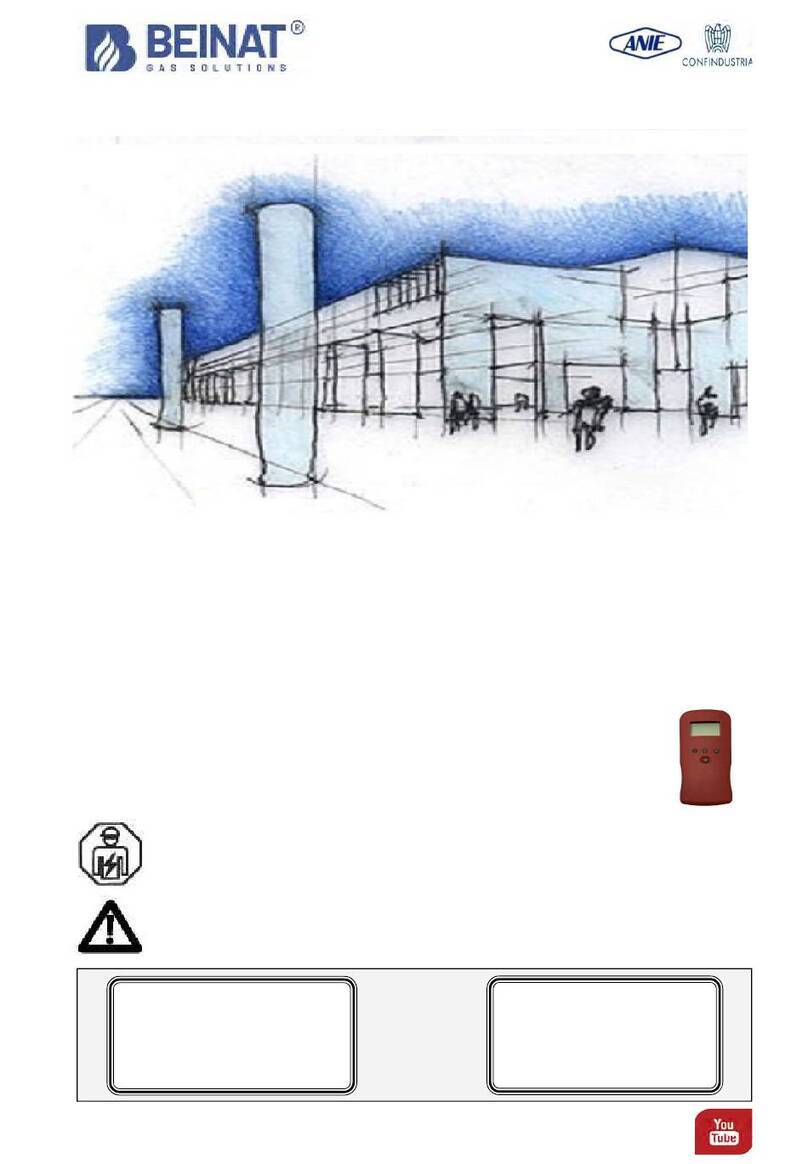
BEINAT
BEINAT SGM595-H2CH User manual
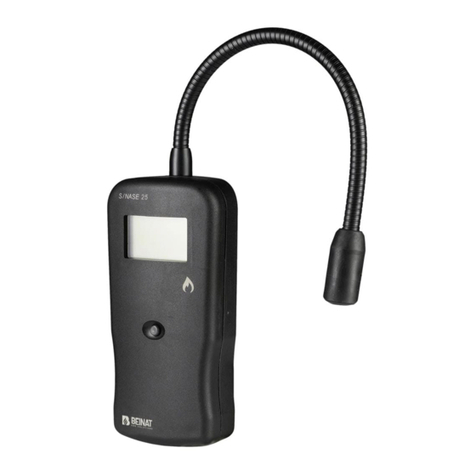
BEINAT
BEINAT NASE25 User manual
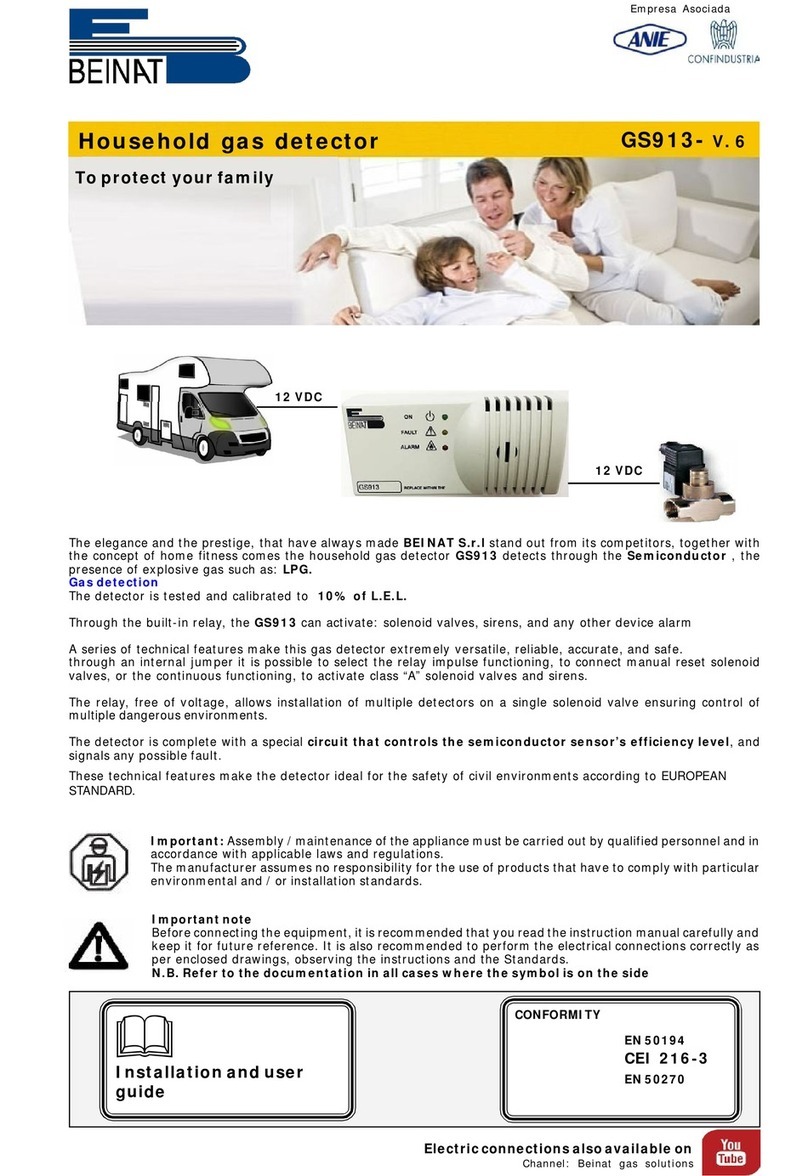
BEINAT
BEINAT GS913- V.6 User manual
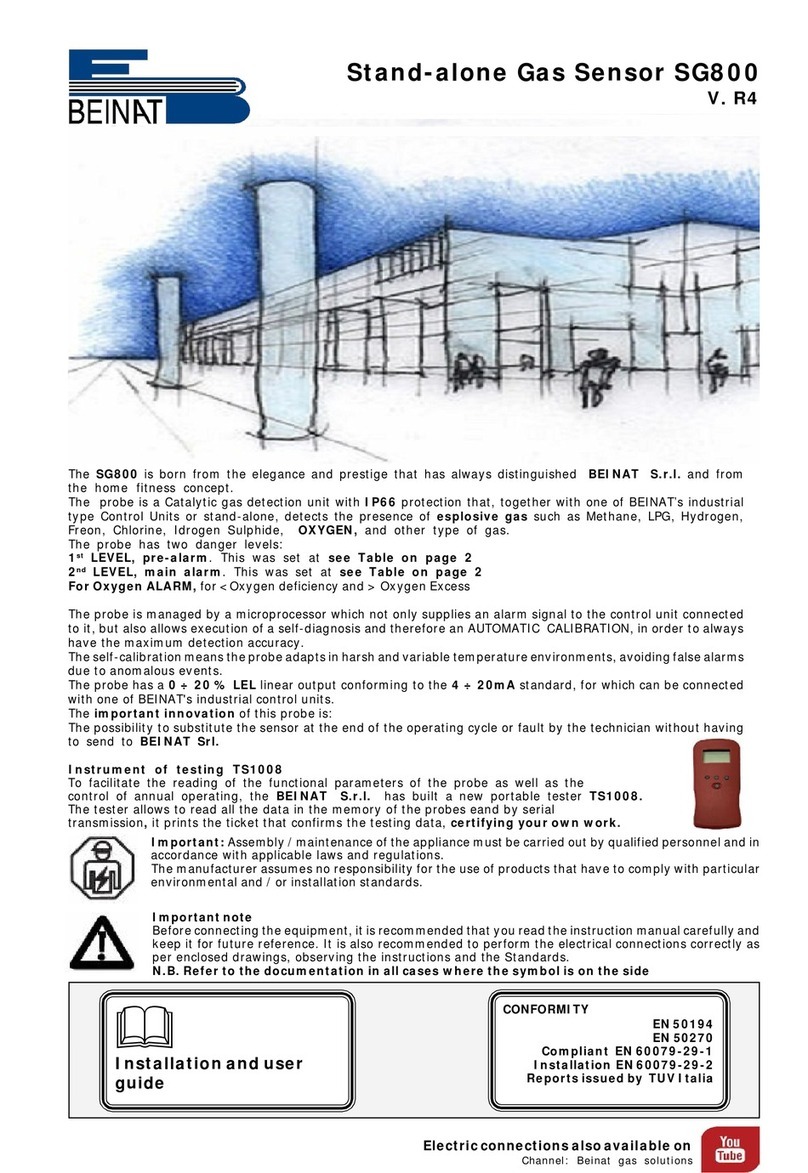
BEINAT
BEINAT SG800 User manual
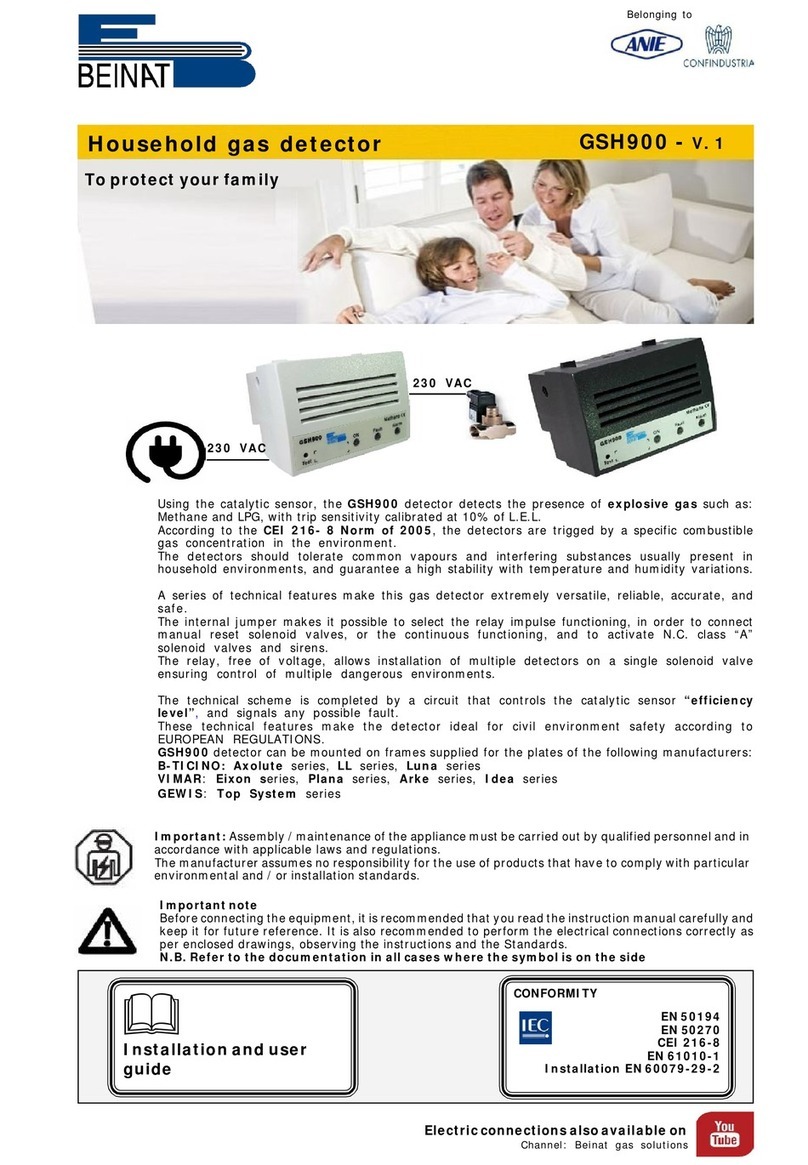
BEINAT
BEINAT GSH900 User manual
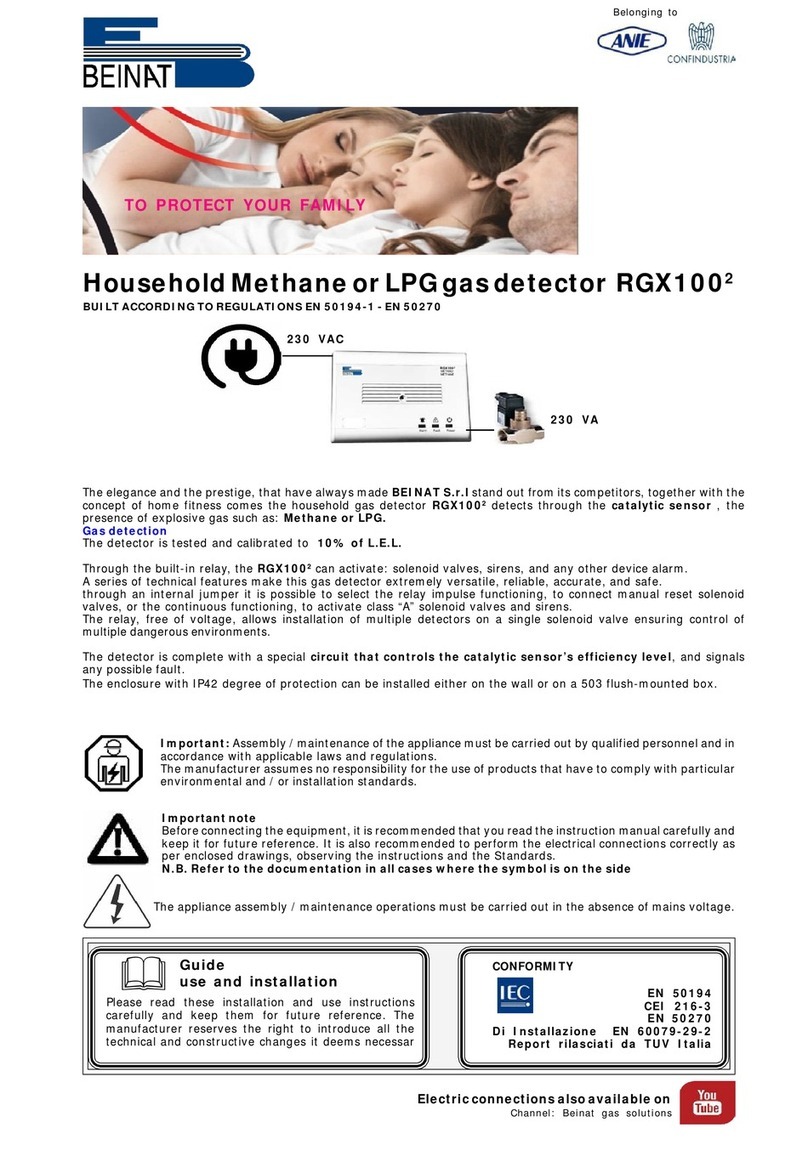
BEINAT
BEINAT RGX1002 User manual
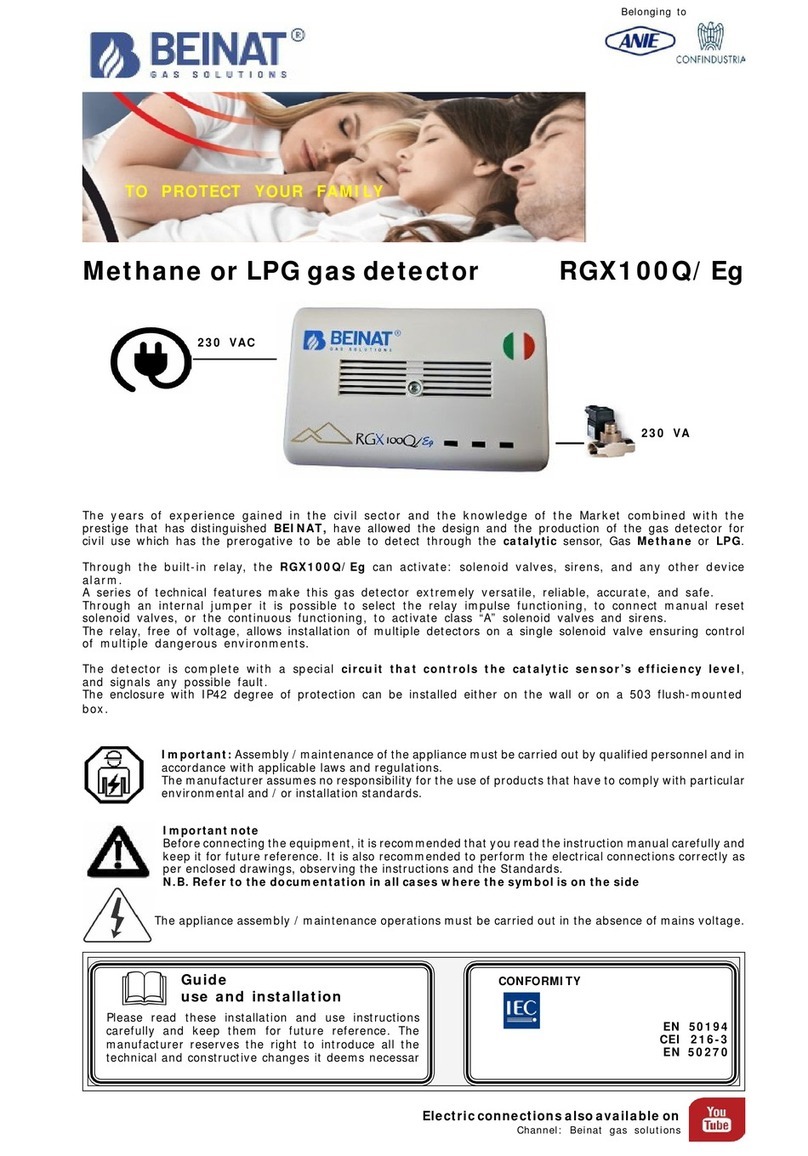
BEINAT
BEINAT RGX100Q/Eg User manual
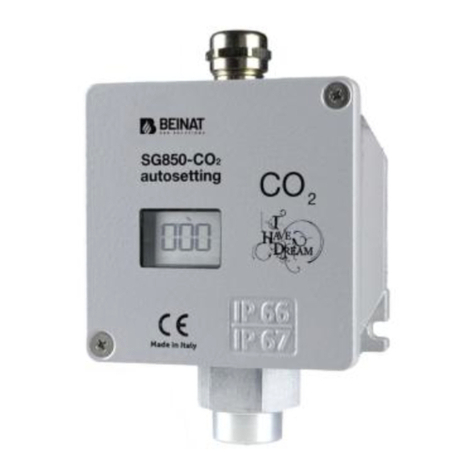
BEINAT
BEINAT SG850 User manual
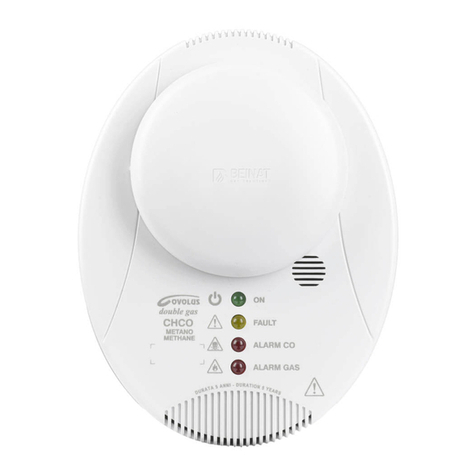
BEINAT
BEINAT CHCO User manual

BEINAT
BEINAT CHCO User manual
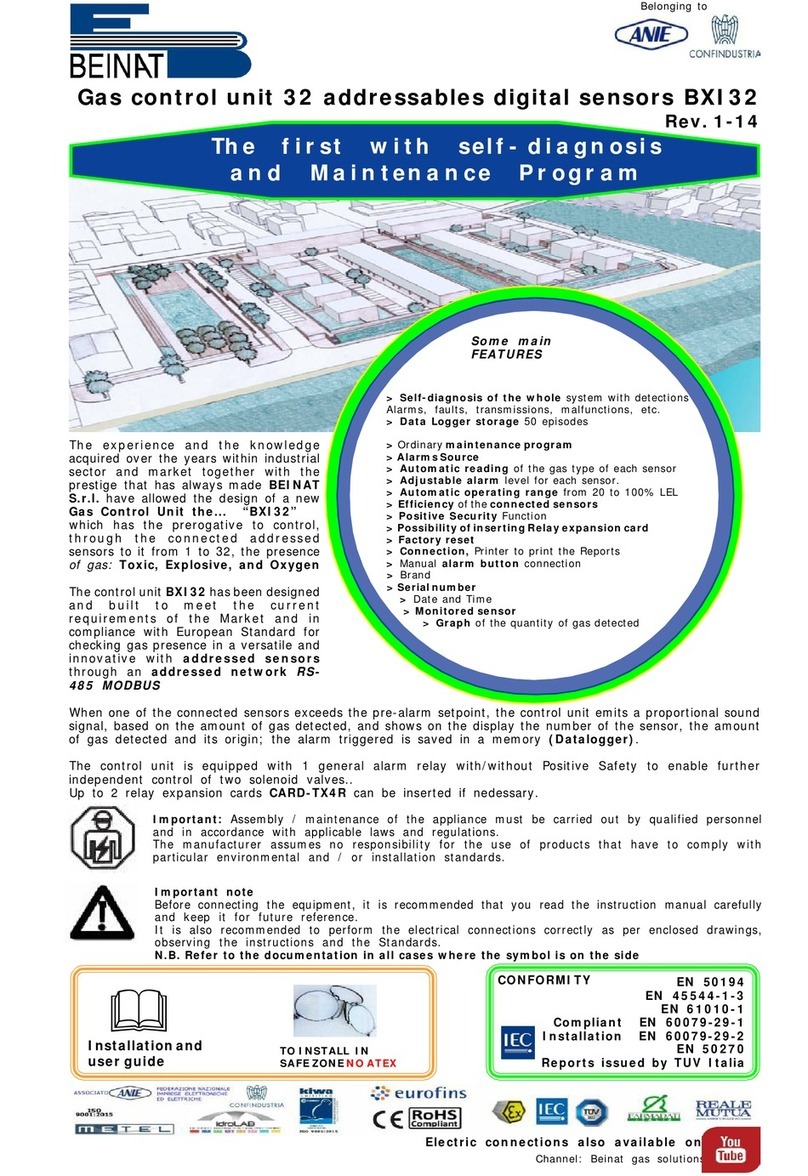
BEINAT
BEINAT BXI32 User manual
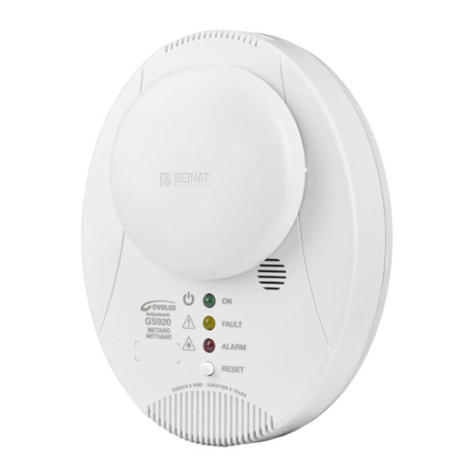
BEINAT
BEINAT GS920 User manual

BEINAT
BEINAT GS911K User manual

BEINAT
BEINAT CO922 User manual
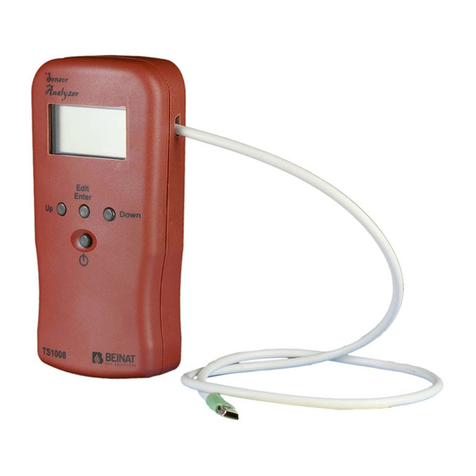
BEINAT
BEINAT SG895 User manual

BEINAT
BEINAT SGM595/A User manual

BEINAT
BEINAT NASE25/S User manual

